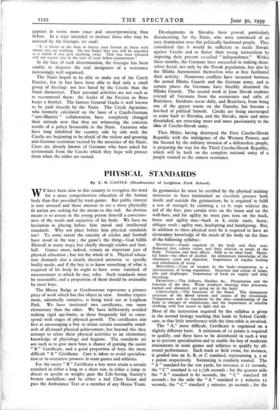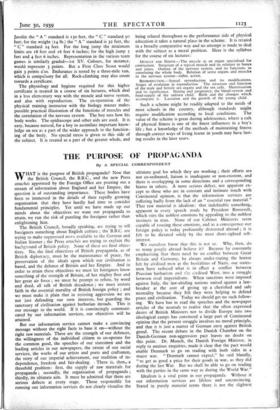PHYSICAL STANDARDS
By E. B. CASTLE (Headmaster of Leighton Park School)
WE have been slow in this country to recognise the need for a more comprehensive education of the human body than that provided by team games. But public interest is now aroused and those anxious to see a more physically fit nation are seeking for the means to this end. An obvious means is to arouse in the young person himself a conscious- ness of the needs and capacities of his body. We have no hesitation in placing before him moral and intellectual standards. Why not place before him physical standards too? To some extent the sanctity of cricket and football have stood in the way ; the game's the thing—God fulfils Himself in many ways, but chiefly through cricket and foot- ball. Games must, indeed, remain an important part of physical education ; but not the whole of it. Physical educa- tion demands also a clearly directed attention to specific bodily needs, and if the boy is to know something of what is required of his body he ought to have some standard of measurement to which he may refer. Such standards must be reasonable, and a proportion of them should be attainable by most boys.
The Moray Badge at Gordonstoun represents a pioneer piece of work which has this object in view. Another experi- ment, admittedly tentative, is being tried out at Leighton Park. We have instituted two certificates, one more elementary than the other. We have deliberately avoided making rigid age-limits, as these frequently fail to corre- spond with stages of physical growth. The certificates aim first at encouraging a boy to attain certain reasonable stand- ards of all-round physical achievement; but beyond this they attempt to relate these physical activities to an elementary knowledge of physiology and hygiene. The standards set are such as to give most boys a chance of gaining the easier " B " Certificate, and a good proportion of boys the more difficult " A " Certificate. Care is taken to avoid specialisa- tion or to overstress prowess in team games and athletics.
For the easier " B " Certificate a boy must attain a certain standard in either a long or a short run, in either a jump or discus or javelin or weight; gain the Life-Saving Society's bronze medallion; and be either a znd Class Scout and pass the Ambulance Test or a member of any House Team. In gymnastics he must be certified by the physical training instructor to have maintained an excellent posture both inside and' outside the gymnasium; he is required to fulfil a test of strength by climbing a 12 ft. rope without the aid of the feet, pass certain tests on the beam and on the wall-bars, and for agility he must pass tests on the buck, horse and agility mat—buck in 8, stride vault; horse, oblique vault ; agility mat, headspring and handspring. But, in addition to these physical tests he is required to have an elementary knowledge of the needs of his body on the lines of the following syllabus:
NuTarrion.—Foods required by the body and their uses. Balanced diet, calorie values and their relation to needs of the body. Vitamins and their effects. Milk as an ideal food. Harm- ful foods—the effect of alcohol. An elementary knowledge of the alimentary canal and digestion. Importance of regular feeding and elimination of waste.
BREATHING.—Uses of oxygen in the body—respiration aS a characteristic of living organisms. Structure and action of lungs, ribs and diaphragm. Importance of fresh air supply and deep breathing.
ExcRunox.—The kidneys, bladder, &c. Perspiration and the function of the skin. Waste products showing what processes, normal and abnormal, are going on in the body.
CIRCULATION.—The functions of the blood. The elementary structure of the blood system and course of the circulation. Temperature and its regulation by the skin—conditioning of the body to changes of temperature, and the importance of sensible clothing, with free access to light and air.
Most of the instruction required by this syllabus is given in the normal biology teaching that leads to School Certifi- cate, so that little interference with the time-table is involved.
The " A," more difficult, Certificate is organised on a slightly different basis. A minimum of 12 points is required to qualify, and these have to be distributed in such a way as to prevent specialisation and to enable the boy of moderate attainments in team games and athletics to qualify by all- round performance. Each track or field event, for instance, is graded into an A, B, or C standard, representing 3, 2 or i points respectively. Swimming is similarly treated. The " A " standard for the ioo yards, for instance, is r r seconds, the " C " standard is 12 r /5th seconds ; for the quarter mile the " A " standard is 6o seconds, the " C " standard 68 seconds ; for the mile the " A " standard is 5 minutes 12 seconds, the " C " standard 5 minutes 3o seconds ; for the Javelin the " A " standard is 13o feet, the " C " standard 90 feet; for the weight (14 lb.) the " A " standard is 32 feet, the " C " standard 24 feet. For the long jump the minimum limits are 18 feet and 16 feet 6 inches; for the high jump 5 feet and 4 feet 6 inches. Representation in the various team games is similarly graded-1st XV. Colours, for instance, would represent 3 points. But a First Class Scout would gain 3 points also. Endurance is tested by a three-mile run, which is compulsory for all. Rock-climbing may also count towards a certificate.
The physiology and hygiene required for this higher certificate is treated in a course of six lectures, which deal in a less elementary way with the muscle and nerve system, and also with reproduction. The co-operation of the physical training instructor with the biology master makes possible practical illustration of the functions of muscles and the correlation of the nervous system. The boy sees how his body works. The epidiascope and other aids are used. It is easy, because natural, for a boy to assimilate important know- ledge on sex as a part of the wider approach to the function- ing of the body. No special stress is given to this side of the subject. It is treated as a part of the greater whole, and being related throughout to the performance side of physical education it takes a natural place in the scheme. It is treated in a broadly comparative way and no attempt is made to deal with the subject as a moral problem. Here is the syllabus for the course of six lectures: MUSCLE AND NERVE.—The muscle as an organ specialised for contraction. Structure of a typical muscle and its relation to bones and joints. Outline of the nervous system, and its functions in correlating the whole body. Relation of sense organs and muscles to the nervous system—reflex action.
REPRODUCTION.—Sexual reproduction and its modifications. Stages of evolution in reproduction The structure and function of the male and female sex organs and the sex cells. Menstruation and its significance. Mating and pregnancy, the blood-system and food-supply of the unborn child. Birth and the changes which accompany it. Lactation and the growth of the young child.
Such a scheme might be readily adapted to the needs of most schools in the country, although standards might require modification according to local conditions. The value of the scheme is great during adolescence, where a cult of physical fitness is one of the finest influences in a boy's life ; but a knowledge of the methods of maintaining fitness through correct ways of living learnt in youth may have last- ing results in the later years.











































 Previous page
Previous page